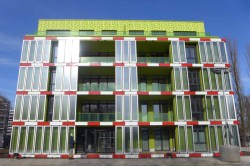
ArupThis building doesn’t just have green paint, it has green algae.
When it comes to powering a home with energy from the sun, solar panels seem passé compared with the technology embedded in the façade of a new apartment building in Hamburg, Germany.
Green slime, not dissimilar to that which taints the Great Lakes and other nutrient-rich water bodies in the warmer months, grows in panels mounted along exterior walls of the Bio Intelligent Quotient (BIQ) House. The algae will be harvested to produce biofuel and help heat the 50 apartments inside.
From the website of the International Building Exhibition:
The sides of the building that face the sun have a second outer shell that is set into the façade itself. Microalgae — tiny plants, most no larger than bacteria — are produced within this shell. They enable the house to supply its own energy. The only thing that the algae have to do is simply to grow. They are continuously supplied with liquid nutrients and carbon dioxide via a separate water circuit running through the façade. With the aid of sunlight, the algae can photosynthesise and grow. This façade is the first of its kind in the world and makes use of the very latest energy and environmental technology. …
The algae flourish and multiply in a regular cycle until they can be harvested. They are then … transferred as a thick pulp to the technical room of the BIQ. The little plants are then fermented in an external biogas plant, so that they can be used again to generate biogas. Algae are particularly well suited for this, as they produce up to five times as much biomass per hectare as terrestrial plants and contain many oils that can be used for energy.
Design powerhouse Arup, the firm behind the building, is pretty proud of itself, suggesting that algae-coated buildings could become commonplace. From The Daily Mail:
Jan Wurm, Arup’s Europe Research Leader, said: ‘Using bio-chemical processes in the facade of a building to create shade and energy is a really innovative concept.
‘It might well become a sustainable solution for energy production in urban areas, so it is great to see it being tested in a real-life scenario.’
The news comes after Arup announced their vision for the future of skyscrapers which suggested that buildings would be ‘living’ buildings powered by algae that respond automatically to the weather and the changing needs of inhabitants.
The $6.6 million BIQ building will be ceremonially switched on next week. And if the façade fails to live up to its clean energy–producing promise, the building will still draw energy from the sun in a more conventional manner: old-fashioned solar panels on the roof.




